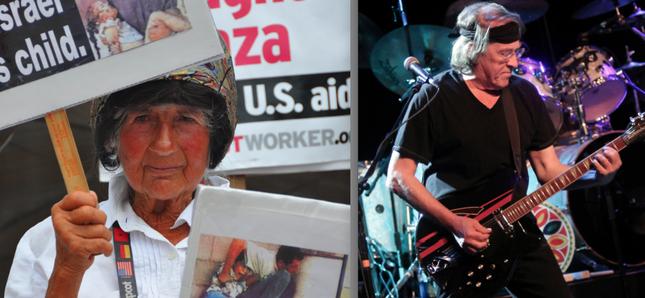American Lives: White House Protestor, Jefferson Airplane Founder
By • March 30, 2016 0 1147

Two people—reminders of different times—passed away recently. One of them was a fixture near the White House for more than three decades; the other, a key member of a legendary 1960s and 1970s rock group, thus adding another name to the recent losses in the rock-pop world.
Concepcion Picciotto in her shawl, heavy hat, standing by her signs and tent protesting nuclear proliferation directly across the street by Lafayette Park, due north of the White House was a familiar figure to passers-by—and the world did pass by and pass her by almost at the same time. Tourists came and walked by as did the day-to-day busy people, especially after two blocks of Pennsylvania Avenue in front of the White House were closed to vehicular traffic in 1995. She and a compatriot William Thomas joined forces—Thomas as a man who founded a more or less steady peace vigil in front of the White House, Picciotto with her long-handed papers protesting and battling the presence and proliferation of nuclear weapons.
Every city has people like this—all different and unique—and places where they gather.
When things happen—the election of an African American president, the killing of Osama Bin Laden—people gather to demonstrate and let their feelings be known, for or against, in front of the north side of the White House. It happens in New York’s Times Square, along Telegraph Avenue in Berkeley, where the intellectuals and the lost got together in the 1960s, accompanied by rock and folk music, or in the parks of Chicago.
People were in front of the gates of the White House at each of the American forays into Iraq or holding vigils for peaces during the holidays. They come to the National Mall in gigantic numbers on Earth Day, on inauguration day, on MLK’s birthday, historic remembrances.
Every big demonstration usually has castoffs, people who come and then somehow forget to leave and go elsewhere. They stick around, having found a place or a home. Picciotto came here after emigrating from Spain in 1960 and eventually, according to various stories, stayed after a failed marriage. She found her cause and her place around 30 years ago. Soft-spoken and quiet, she never yelled or screamed, but rather put up pamphlets, whole tomes on the danger of nuclear war and proliferation. In a story by George Joseph Tanber in the Toledo Magazine in 1988, she would begin her days at 8 a.m., feed squirrels and set up her place and the signs: “Live by the Bomb; Die by the Bomb” and so on. As far as any one knows, she must have seen a few presidents go by, beginning with Ronald Reagan, but no exchanges have been recorded. She had run-ins with the Secret Service Police, often talked with people and remained a regular presence.
She died at the age of 80 on Jan. 25 at N Street Village, a homeless shelter and rehabilitation center for women, six blocks from the White House.
If you lived in the San Francisco Bay Area, were young, restless and a little hippified, lived in Marin County or thereabouts and read about the new music in stories by local sage Ralph Gleason, you knew who Paul Kantner was. More accurately, you knew him as the guitarist and founding member of Jefferson Airplane, one of the major rock groups of the 1960s, legends in their mind and the minds of the fans who were often carried high by the music and the smoke.
His death evokes not only the memory of the sound of the Jefferson Airplane’s music but the memory of a scene—that was San Francisco in the mid-to-late-1960s, when some of the most legendary singers, bands, and musicians rose out of the ashes of the folk scene to become major stars and emblematic of a pop culture (in the Haight Ashbury and in and around the Bay Area). At the Fillmore and the Avalon, the Airplane, Janet Joplin and Big Brother and the Holding Company, Quicksilver Messenger Service, the Byrds and Steve Miller’s Blue Band were at the forefront of a musical movement and moment.
The Airplane’s big star was Grace Slick, the slickest female singer around, a kind of glamour queen of the movement, which had Joplin as its break-your-heart soul. Slick and Kantner were the power couple of the movement—they had a daughter named China. The band—Slick, Kantner, vocalist Marty Balin, guitarist Jorma Kaukopnen, bassist Jack Casady and drummer Spencer Dryden—took off with such hits as the irresistible “Somebody to Love” (as in “Don’t You Want Somebody To Love”) and the enigmatic-to-Middle-America “Go ask Alice”, which married Lewis Carroll to the counter culture. The band broke up in the late 1960s, and Kantner and Casady founded Hot Tuna while others centered around “Starship.”
At its height, Jefferson Airplane was something to behold and hear, one of the centerpieces of a whirling, colorful, unforgettable scene.
Kantner died January 28 in San Francisco at the age of 74.

